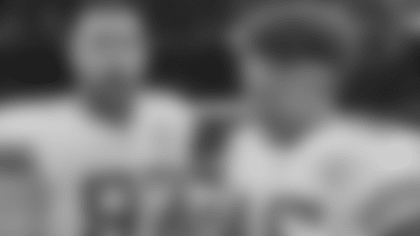
There were a lot of emotions that were brought to the forefront from Sunday's loss against Washington, and near the top of the list is frustration. The fans are frustrated, especially after such an exciting offseason and preseason buildup to this fall. The players are obviously frustrated with their performance, that's obvious when you hear them talk after the game. Clearly the coaches aren't happy with the 1-3 start.
Before I get into the breakdown from Sunday, however, I will put this out there. This is the beauty of the NFL as opposed to college football. In college, if you lose two games (and in most cases, even just one game), your preseason goals are no longer within reach. Your journey won't end with you hoisting a championship trophy. In the NFL, there are plenty of instances over the last few years of teams that started slow out of the gate, were left for dead by fans and media, and rallied to make the playoffs and go further than most expected. From Tom Brady's debacle last year against Kansas City to the Giants' Super Bowl run in 2007, teams have shown in the past that early-season stumbles don't always carry through.
Now, the questions that this team will have to answer in the coming weeks are: Is this an early stumble? Can these mistakes be fixed? How quickly can things like execution be corrected? This team had a slow start in 2013, and they had trouble getting things going offensively in the first half of last season as well. Both times they were able to rebound and put themselves in position at the end of the year. Can they repeat that performance? That's the question facing the team right now, and the only way to answer it is by going one week at a time, fixing the small errors that lead to bigger ones and improving game to game. Now, let's look at what needs to be fixed.
Head coach Chip Kelly has long said that the time-of-possession statistic isn't as important as the number of plays run, and he's 100 percent right. Plenty of teams win even though they lose the T.O.P. battle, and many lose games when they hold the ball longer than their opponent. But running more plays than the opposing team is the number that matters, and right now that's not happening. Why isn't that happening? Because of the struggles on third down.
The Eagles were just 4-of-12 against Washington on third down, with lots of contributing factors. On some plays, particularly late in the game, there were key drops (an issue that has haunted the Eagles through various points of the first month of the season). On other plays, they were able to get a completion and just come up short. The other reason, and this is something that Kelly talked about after the game, is that they were unable to protect Sam Bradford. On four of those eight failures on third down, Bradford was either sacked or pressured into an incompletion.
As is often the case with teams that struggle on third down during a game, the problem didn't start there. Often, it's problems on first down that prevent offenses from being in manageable situations when it counts. The Eagles had 24 first-and-10 situations on Sunday. Of those 24 plays, 14 of them went for 3 yards or fewer, with only eight of them going for more than 4 yards. When you don't have success on first down, you often have trouble getting into manageable third down situations, and now you're fighting an uphill battle to move the chains.
When you struggle to convert on third down (according to ESPN Stats & Info, the Eagles are punting on the highest percentage of drives this season at 52.5 percent), you're running fewer plays offensively. The Eagles will have to get this problem corrected moving forward, but as we've talked about in the past, it's not just one player who needs to be changed or one scheme that isn't working, there's no one problem, it's across the board and must be a team-wide effort to get it fixed.
One facet of the game on Sunday that I was really happy to see come to light was the vertical passing game. We've seen some shots here and there from this offense, but against Washington's defense they clearly thought they had the ability to attack them down the field, and that showed up on tape. Bradford was able to take advantage of some of those opportunities.

Remember the game last year against Washington in Week 3? It was the return of DeSean Jackson and there was the fight that broke out late in the game after a hit on Nick Foles. What I remember most from that day, however, was that it was Jordan Matthews' breakout game, as he scored two touchdowns on basically the exact same play design. The defense was in Cover 3, and the offense attacked it with four verticals. It was second-and-15 late in the first half, and this play call against this coverage will work pretty much every time, as long as you are able to protect up front.

The Eagles are unable to give Bradford enough time to let this play develop. By the time the coverage has declared itself, and he's got two vertical routes screaming at a safety in the middle of the field (there's no way he can cover both), Bradford is forced out of his progressions and brought down for the sack. On the next play, Bradford hit Cooper for a 10-yard gain on third down, but a missed field goal kept the Eagles off the scoreboard.
These kinds of opportunities didn't just happen down in the red zone though. Here's a play from the team's very first drive.

It's third-and-10, and the Eagles are running what's called a "Dagger" concept with Nelson Agholor running a dig route into the middle of the field. That area he's running into should be empty, as two vertical routes from the slot will clear out space between the number and the hashmark, opening a window for Bradford to deliver the football.

As you can see, the play worked. The window is open for Bradford. But he's unable to get the ball out because of pressure and is brought down for an 8-yard loss. On both of those plays above, the Eagles were operating out of long distances (second-and-15 and third-and-10), so it's not just these plays in a vacuum. The execution across the board has to be more consistent to put this offense in a position to make plays up and down the field.
Again, the plays were there down the field for this offense, and on multiple occasions Bradford was able to come up big. Other than Cover 3, another coverage was Quarters coverage, or different versions of it. On the Kickoff Show, I asked Greg Cosell to break down the way to beat Quarters, showing how the Eagles had done it before. That came into play on Sunday.

It's second-and-5, and Washington is playing what's called "Quarter-Quarter-Half" coverage, with quarters to one side of the field and Cover 2 to the other. The Eagles run a play concept that attacked the coverage perfectly.
The key to quarters coverage is that, despite the fact that you have four defenders responsible for the deep area of the field, the two safeties in the middle have run responsibilities underneath. So any kind of run threat is something that will handle their attention. The outside zone-action from running back DeMarco Murray holds the safety to the boundary in place. With that safety's eyes in the wrong place, Agholor has room to run his deep post route toward the middle of the field. The cornerback covering Agholor plays with outside leverage, funneling Agholor inside because he thinks he has safety help, but since that safety is worried about the run, there's no one there and Agholor reels in the acrobatic one-handed catch for a big play and a first down.
This was the biggest play of Agholor's season thus far, and the Eagles were hoping to keep that momentum rolling on the very next play, calling an "S Reverse" with Agholor (S standing for slot receiver).

With Riley Cooper to that side of the field along with left tackle Matt Tobin releasing to the second level, if this play works right it should be a big play.

Unfortunately, we know how this play ends. There's a fumble on the exchange from Ryan Mathews to Agholor, and what could've been a big play for the Eagles' offense turns into a catastrophic turnover to kill the momentum. As you can see, this was set up beautifully by the coaching staff, and if it was executed correctly it may have been a long touchdown run for the rookie first-round pick.
The Eagles went into the locker room at halftime down 13-0, having failed to sustain and ultimately finish drives offensively for a number of different reasons. They made some adjustments, fixed some things up front and were able to execute at a higher rate in the second half, and it resulted in them scoring on their opening possession.

This has always been one of the Eagles' go-to passing plays, and it's effective because it attacks every area of the field. It worked on Sunday against Washington thanks to great execution across the board.
Bradford drops back and starts to his right, where he has a vertical route from No. 1, a flat route from No. 2 and a bit of a crossing route coming from the other side of the field from the tight end. Bradford's eyes help to move that safety in the middle of the field, causing him to cheat more toward the right. By doing that, Cooper now has a ton of green grass to run to and Bradford sees that and delivers the ball perfectly up the hash for the touchdown. The protection was great, the quarterback was great and everyone was in the right place from a receiver standpoint. With all their ducks in a row, the Eagles get on the board and make it a one-score game.
Bradford was able to hit on multiple vertical passes against Washington, including a long touchdown to Miles Austin and a go route down the middle to Matthews, among others. He proved again on Sunday that, when he's given the time, he can spread the ball around and deliver it to the wide array of targets in this passing game, as long as everyone across the board is able to execute.
Fran Duffy is the producer of "Eagles Game Plan" which can be seen on Saturdays during the season. Be sure to also check out the "Eagle Eye In The Sky" podcast on the Philadelphia Eagles podcast channel on iTunes. Prior to joining the Eagles in 2011, Duffy was the head video coordinator for the Temple University Football team under former head coach Al Golden. In that role, he spent thousands of hours shooting, logging and assisting with the breakdown of the All-22 film from the team's games, practices and opponents.























